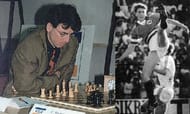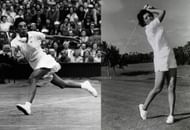Barty at WimbledonBarty at the GabbaAustralian tennis star Ashleigh Barty made news in the past week when she switched her tennis racquet for a cricket bat and signed a contract to play for the Brisbane Heat in the Women’s Big Bash League.Barty decided to make the switch after a meeting with the Australian women’s national team. She was taken in by the camaraderie of the team environment."It is tough when you're by yourself and I think that's why team sport is so appealing,” she said."I'm still connected very much to tennis and everything it has to offer. It's been a part of me since I was four years old and is never going to leave me."The 19-year-old has had a promising tennis career thus far. She found recognition on the professional tennis circuit when she reached the doubles finals at the Australian Open and Wimbledon, with her Australian partner Casey Dellacqua). She was also a champion at Wimbledon in the juniors.And she seems to have a flair for cricket already. Even though it has only been a few months since she began traiing for the game, she has already secured a professional contract.Barty is not the first athlete to play multiple sports professionally. Injuries, burn-outs, discovery of a new passion, prodigal skills and even plain boredom have been some of the reasons that have seen many athletes dabble in other sports.Here is a look at some of the interesting multi-sport athletes and the stories behind their careers.
#1 Andrew Flintoff: Cricket and Boxing

Andrew ‘Freddie’ Flintoff was the ultimate character in men’s cricket and the talisman of England’s Ashes victories in the past decade. The Lancashire all-rounder was an explosive middle-order batsman. Although he batted in a carefree manner, he possessed the ability to take the game away from nearly any situation. He was also a genuinely fast bowler (he has bowled consistently at 150 km/h).
And if he didn’t get you with his cricket skills, he certainly made his presence felt through his on-field banter, sledging and aggression in the batsmen’s faces. He is one of the seven international cricketers to feature on both, the batting and bowling, honour boards at Lord’s.
His cricketing career was consistently riddled with injuries and he ultimately called it a day from all forms of the game in 2010 after not recovering sufficiently from deep vein thrombosis.
In 2012, at the age of 34, Flintoff took the world by surprise by announcing his decision to take up professional boxing. After just a couple of months of training, he made his debut against the American Richard Dawson in a heavyweight bout.
He came under heavy criticism for this decision, not in the least because the seasoned pro boxers felt that it was a mere gimmick. Flintoff won the match on points (39-38). But despite the successful start, he only ever played that one match.
tHe never took to the ring after that. In a 2014 interview, he said, “I enjoyed the training but didn’t enjoy the fighting. I’m not that aggressive. It wasn’t about winning or losing. I had retired from cricket and still wanted to be a professional sportsman. It was my last opportunity and helped give me some closure.”
Bonus – Another cricketer, New Zealand’s Jesse Ryder has also taken up boxing, albeit at an amateur level. The much in news ‘southpaw’ batsman still continues to play professional cricket and engages in celebrity bouts on the sideline, occasionally issuing challenges to other cricketing celebrities.
#2 Simen Agdestein: Football and Chess

Simen Agdestein was a striker for the Norwegian club Lyn Oslo. Playing in the late 80s and early 90s, he made 92 appearances for Lyn Oslo and scored 37 goals. He also made 8 appearances for the national team and scored 1 goal. However, a knee injury put an end to his football career. It was a good thing he already had a knack for chess.
Agdestein started playing chess when he was 4 or 5. At the age of 15, he became the Norwegian champion. At 16, he was an International Master. At 18, he was a grandmaster. In the 1986 World Junior Championship, he finished second, ahead of Viswanathan Anand. In 1987, his ELO rating crossed 2600.
In fact, he did all this while simultaneously playing professional football. He would frequently take a few weeks off in the middle of the football season to participate in chess tournaments around the world.
Agdestein seems to have thrived in the dual challenge of both the sports for he achieved his best when he was playing at the highest level in both. His forced withdrawal from football affected his performance in chess and he dropped to 87 in the world rankings.
More debilitating injuries nearly forced him to abandon chess as well. However, his condition improved and he took up a job in the Norwegian Academy for Elite Sports and began coaching in both the sports.
Bonus – In the early 2000s, Adgestein began coaching Magnus Carlsen, who would go on to become the top ranked chess player and achieve the highest ever ELO rating in the history of the sport.
#3 Althea Gibson: Tennis and Golf

In a time when racism was rife in sports as in society, Althea Gibson was the trailblazer who paved the way for many stars of the future. Yet, Gibson continued to struggle against discrimination all through her life.
Growing up in New York, she developed her tennis skills while playing paddle tennis in the streets of Harlem. With the support of her neighbours, she was able to embark on a career in tennis and played at the topmost level by the age of 23. She became the first black player ever to play in the US National Championships. She lost in a close three-set match to the reigning Wimbledon champion.
Success came in 1956 when she won the French Open. Then, in 1957, she reached the final of the Australian Open, won Wimbledon and the US Open. She became the first Wimbledon champion ever to receive the trophy from the Queen.
She defended her titles again in 1958. Despite the success, the amateur status of the competition meant that Gibson made no income through her victories. With professional tennis still years away, she initially turned to playing organised exhibitions. However, few opportunities came her way, perhaps because of her race.
In 1964, Gibson joined the Ladies Professional Golf Association. Racial discrimination continued to haunt her as she was denied entry into many hotels and golf club houses. She often had to changer her clothes in her car. She had decent success on the course, though, setting several course records and finishing 2nd in a tournament in 1970. She achieved a career high ranking of 27 in 1966.
Bonus – Gibson is only the 2nd African American to be given a ticker tape parade reception in New York City following her success at Wimbledon. The first was Jesse Owens.
#4 Denis Compton and Leslie Compton - Cricket and Football

One was England’s most remarkable batsman and the other a mainstay in the defence of the Arsenal and England. Simultaneously, one was a left winger for Arsenal and the other a wicket-keeper for Middlesex.
In a career spanning, two decades, Denis Compton accomplished many laurels as a batsman. He played 78 test matches for England and 515 first-class matches for Middlesex and scored 44749 runs at an average of 51.6. He is one of the 25 players to have scored more than a 100 first-class centuries. His football career was slightly shorter and he made much fewer appearances than Leslie.
Leslie played for the Gunners for nearly 22 years and earned 253 caps. He was also, briefly, the captain of the team. He made his debut for England against Wales in 1950. He became the oldest post-war debutant for England and the oldest ever outfield player to debut, a record which still stands.
The Comptons won the FA Cup in 1949-50. In the semi-final against Chelsea, the Gunners were trailing by a goal when, in the dying stages of the match, they won a corner. Denis took the kick and Leslie headed it into the goal.
The Comptons also won the 1947 county championships. Denis was already an established Test player by that time and was the main star of the team and a national hero. Leslie, while less known for his cricketing prowess, played a crucial role the latter rounds, scoring a century in 87 minutes after a hat-trick had left his side in a precarious situation. Middlesex went on to win the championships two matches later.
The Comptons are the only brothers to have won the national titles in cricket as well as football.
Bonus – Denis was notoriously absentminded. So much so that he ran his brother out in the latter’s testimonial match with Middlesex.
#5 C.B. Fry: Football, Cricket, Track and Field and Rugby Union

C.B. Fry was a polymath. He excelled in the languages, fluent in Latin, Greek, French and German. He attended Wadham College, Oxford on a scholarship and won the ‘Blue’ (awarded to students who compete at the highest level) there for cricket, football and athletics.
As a highly effective right-handed batsman, Fry played 26 test matches for England, captaining them in his last 6. His career first class batting average is above 50 and he scored nearly 32,000 runs. He made six consecutive centuries in 1901, a record which still stands today.
In athletics, he set the set the university record and equalled the world record in long jump. His university record would stand 21 years. He won the 100 yards sprint in the first international college level meet and was the president of the Oxford University Athletics Club.
As a footballer, Fry was the captain of his school and college team. He played amateur football for the Corinthians before turning professional and won the Southern League title with Southampton F.C. in 1901, reaching the FA Cup final with The Saints in 1902. He earned an England call-up in 1901, and played just that one game for them against Ireland.
Fry was also in the Rugby team during his time at Oxford and made numerous appearances in professional rugby matches afterwards.
He was a man of quite a few eccentricities. He was known for wearing ridiculous outfits, dabbled in politics, became a member of the Liberal party and lost the general election from Banbury by a mere 219 votes. In his later life, he also published a magazine and provided commentary on cricket.
To quote the famous cricket writer Sir Neville Cardus, “he was one of the last of the English tradition of the amateur, the connoisseur, and, in the most delightful sense of the word, the dilettante.”
Bonus – Fry tried convince Hitler and Joachim von Ribbentrop (Germany’s then- Foreign Minister) to take cricket to Test match level in Nazi Germany.
Brand-new app in a brand-new avatar! Download CricRocket for fast cricket scores, rocket flicks, super notifications and much more! 🚀☄️
